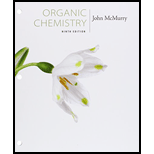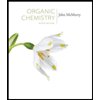
Bundle: Organic Chemistry, 9th, Loose-Leaf + OWLv2, 4 terms (24 months) Printed Access Card
9th Edition
ISBN: 9781305701021
Author: John E. McMurry
Publisher: Cengage Learning
expand_more
expand_more
format_list_bulleted
Textbook Question
Chapter 3.SE, Problem 26AP
Draw the structures of the following molecules:
(a) Biacetyl, C4H6O2, a substance with the aroma of butter; it contains no rings or carbon-carbon multiple bonds.
(b) Ethylenimine, C2H5N, a substance used in the synthesis of melamine
(c) Glycerol, C3H8O3, a substance isolated from fat and used in cosmetics; it has an -OH group on each carbon.
Expert Solution & Answer
Trending nowThis is a popular solution!

Students have asked these similar questions
Hello I need homework help. Please focus on box 2 and 3, box 1 is correct.
Using first- and second-order integrated rate laws
At a certain temperature the rate of this reaction is second order in H3PO4 with a rate constant of 0.709M¯¯
2H3PO4 (aq) → P₂O5(aq)+3H₂O(aq)
-1
-1
·S
Round your answer to 2 significant digits.
Suppose a vessel contains H3PO4 at a concentration of 0.880M. Calculate how long it takes for the concentration of H3PO4 to decrease to 0.141M. You may
assume no other reaction is important.
x10
?
00.
18
무
Naming coordination compounds
Name these coordination compounds.
formula
[FeCl2 (CO)4] Cl
Na₂ [MnBr, (NH)₂]
4
[GCL (H,0),]C
name
Х
000
18
Ar
Chapter 3 Solutions
Bundle: Organic Chemistry, 9th, Loose-Leaf + OWLv2, 4 terms (24 months) Printed Access Card
Ch. 3.1 - Prob. 1PCh. 3.1 - Prob. 2PCh. 3.1 - Identify the functional groups in the following...Ch. 3.2 - Draw structures of the five isomers of C6H14.Ch. 3.2 - Propose structures that meet the following...Ch. 3.2 - Prob. 6PCh. 3.3 - Draw the eight 5-carbon alkyl groups (pentyl...Ch. 3.3 - Identify the carbon atoms in the following...Ch. 3.3 - Prob. 9PCh. 3.3 - Prob. 10P
Ch. 3.4 - Give IUPAC names for the following compounds:Ch. 3.4 - Prob. 12PCh. 3.4 - Name the eight 5-carbon alkyl groups you drew in...Ch. 3.4 - Give the IUPAC name for the following hydrocarbon,...Ch. 3.7 - Make a graph of potential energy versus angle of...Ch. 3.7 - Sight along the C2-C1 bond of 2-methylpropane...Ch. 3.7 - Sight along the C2-C3 bond of 2,3-dimethylbutane,...Ch. 3.7 - Draw a Newman projection along the C2-C3 bond of...Ch. 3.SE - Prob. 19VCCh. 3.SE - Prob. 20VCCh. 3.SE - Draw a Newman projection along the C2-C3 bond of...Ch. 3.SE - Prob. 22APCh. 3.SE - Prob. 23APCh. 3.SE - Propose structures for the following: (a) A...Ch. 3.SE - Prob. 25APCh. 3.SE - Draw the structures of the following molecules:...Ch. 3.SE - Draw structures that meet the following...Ch. 3.SE - Prob. 28APCh. 3.SE - In each of the following sets, which structures...Ch. 3.SE - There are seven constitutional isomers with the...Ch. 3.SE - Prob. 31APCh. 3.SE - Draw compounds that contain the following: (a) A...Ch. 3.SE - Prob. 33APCh. 3.SE - Draw and name all monochloro derivatives of...Ch. 3.SE - Draw structures for the following: (a)...Ch. 3.SE - Prob. 36APCh. 3.SE - Draw a compound that: (a) Has nine primary...Ch. 3.SE - Give IUPAC names for the following compounds:Ch. 3.SE - Name the five isomers of C6H14.Ch. 3.SE - Explain why each of the following names is...Ch. 3.SE - Prob. 41APCh. 3.SE - Consider 2-methylbutane (isopentane). Sighting...Ch. 3.SE - What are the relative energies of the three...Ch. 3.SE - Construct a qualitative potential-energy diagram...Ch. 3.SE - Prob. 45APCh. 3.SE - Draw the most stable conformation of pentane,...Ch. 3.SE - Draw the most stable conformation of...Ch. 3.SE - Prob. 48APCh. 3.SE - Prob. 49APCh. 3.SE - Formaldehyde, H2C=O, is known to all biologists...Ch. 3.SE - Prob. 51APCh. 3.SE - Increased substitution around a bond leads to...Ch. 3.SE - Prob. 53APCh. 3.SE - In the next chapter we'll look at...Ch. 3.SE - We’ll see in the next chapter that there are two...
Knowledge Booster
Learn more about
Need a deep-dive on the concept behind this application? Look no further. Learn more about this topic, chemistry and related others by exploring similar questions and additional content below.Similar questions
- Why does this phenomenon of optically active occur? As you observed in the lab, why do the various compounds alter the results? What causes the differences? How do you know these molecules are all optically active, if they are? How does the concentration, purity, and identity of the substance effect the results? What must occur for the phenomenon to be observed?arrow_forwardDeducing a rate law from the change in concentration over time A chemistry graduate student is studying the rate of this reaction: 2NH3 (g) → N2 (g) +3H₂ (g) She fills a reaction vessel with NH3 and measures its concentration as the reaction proceeds: ? time (minutes) [NH3] 0 1.00M 1.0 0.571M 2.0 0.400 M 3.0 0.307M 4.0 0.250M Use this data to answer the following questions. Write the rate law for this reaction. rate k ☐ x10 Calculate the value of the rate constant k. k = ☐ Round your answer to 2 significant digits. Also be sure your answer has the correct unit symbol. G 000 18 Ar 。arrow_forwardWriting the rate law implied by a simple mechanism Suppose the formation of dinitrogen pentoxide proceeds by the following mechanism: step elementary reaction - 1 NO2(g) + O2(g) → NO(g) + O2(g) 2 NO3(g) + NO2(g) → N₂O(g) rate constant k₁ k₂ Suppose also k₁ «k2. That is, the first step is much slower than the second. Write the balanced chemical equation for the overall chemical reaction: Write the experimentally- observable rate law for the overall chemical reaction. Note: your answer should not contain the concentrations of any intermediates. ☐ rate = ☐ Express the rate constant k for the overall chemical reaction in terms of K1, K2, and (if necessary) the rate constants k-1 and K-2 for the reverse of the two elementary reactions in the mechanism. k = ☐ Х 5 olo 18 Ararrow_forward
- 18. A 10.2g piece of coal (carbon) is combusted completely beneath a calorimeter containing 800.0 mL of water. The initial temp of the water was 20.0°C, and the final temp was 62.7°C. Assuming complete transfer of heat from the carbon to the water, what is the molar enthalpy of combustion of carbon?arrow_forwardpls help asap on all.arrow_forwardpls help asap on all.arrow_forward
- Use the reaction coordinate graph below to answer questions 13-15: 13. Which step is the rate determining step? a. C→ E b. E→ G C. A → C d. Not enough information 14. The overall reaction: a. is exothermic b. is endothermic C. has no change in energy Energy d. not enough information 15. The activation energy for the overall reaction would be equal to: a. Ꭰ A b. F C. B d. B + D + F B 0 D E Reaction coordinate Garrow_forwardpls help asap on all.arrow_forwardpls help asap on all.arrow_forward
arrow_back_ios
SEE MORE QUESTIONS
arrow_forward_ios
Recommended textbooks for you

07 Physical Properties of Organic Compounds; Author: Mindset;https://www.youtube.com/watch?v=UjlSgwq4w6U;License: Standard YouTube License, CC-BY